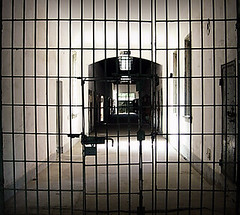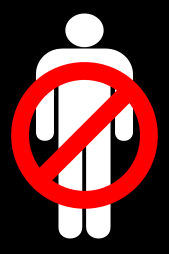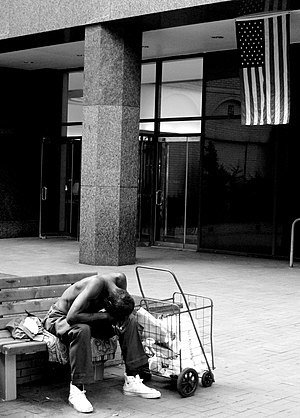
“Nickelsville” homeless encampment (named after Seattle Mayor Greg Nickels) towards the end of its 3-month stay in the parking lot of the University Congregational United Church of Christ in the University District, Seattle, Washington. (Photo credit: Wikipedia)
Since the US and world economies cratered in 2007 there has been a large increase in homelessness. Supportive services have become overburdened, and many people have abandoned the shelter system altogether and moved into tent cities.
In 1990 Seattle had one of the first tent cities, created by a sponsoring organization called SHARE. Twelve years later Seattle became the first major American city to accept the basic tent city operating principles. Ever since, two tent cities have operated under city and local ordinances—and one has operated unsanctioned—each relocating every three months. They are hosted by a rotation of churches.
Neil Donovan, executive director of the National Coalition for the Homeless, in a 2010 report declared:
Tent cities are Americans’ de facto waiting room for affordable and accessible housing. All developed nations have supportive public housing with varying levels of volume and efficacy, but many housing options take months or years to get into.
It is ironic that while US homelessness is increasing, 11% of houses stand empty. Tent cities are a pragmatic, short-term way to widen the safety net for people in danger of losing their homes. If permanent housing for all homeless people becomes unrealistic, the model of transitional housing in organized tent cities could prevent both temporary and absolute homelessness.
Many churches like to host tent cities, as it allows them to help the people most in need.
Despite high unemployment, many tent city dwellers work day jobs, and some tent cities are based around employment opportunities. In Fresno, CA, for example, Little Tijuana is a predominantly Hispanic tent city comprised of many migrant workers who can’t afford housing or don’t want to take the risk of signing a lease.
Portland, Oregon’s Dignity Village is a self-governed, self-funded community founded by homeless people (all of whom have since moved on to permanent housing or elsewhere). In its 13-year life, it has evolved from a traditional tent city into an “eco-village,” with help from local non-profit organizations and community donations. Its houses are made from recycled materials, and amenities include 24-hour security, an organic farm and city-provided waste removal and recycling. This autonomous community remains relatively safe by throwing out residents who bring drugs or alcohol onto the site. Portland police believe that Dignity Village makes their jobs easier.
Seattle Deputy Mayor Darryl Smith concludes:
We have people in this city sleeping outside. That’s reality. So let’s create as many options as we can.









































